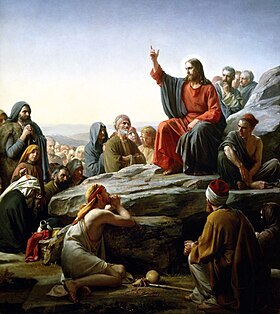“And the angel answered her, “The Holy Spirit will come upon you, and the power of the Most High will overshadow you; therefore the child to be born will be called holy—the Son of God.” (Luke 1:35)
The Holy Trinity chose to take its “repose” in Mary in order that the Holy Spirit could bring forth a God-man, Jesus Christ, through the unspeakable grace of the true and never-ending maternity of Mary Immaculate who is, and will always be, the Mother of God. Through Mary’s consent, the Holy Spirit’s shadow covered Mary, and she conceived our Savior in her womb (Luke 1:35). Even now in Heaven she is truly the Mother of Jesus Christ.
Although we are all adopted sons and daughters of God through baptism, Mary is, as Saint Maximilian Kolbe points out, the actual Mother of God! There is, then, a unique and special relationship between Mary and the Holy Trinity that far exceeds in profundity our understanding. We can only approach this mystery in love.
Mary’s supreme office then – her predestination we might say – is that of Mother! And since she is the mother of the first born of all the elect, Jesus Christ, she is our Mother too. She intercedes for us as a good Mother – no, much more, as “the best of Mothers!” Jesus bequeathed her to us!! “Behold your Mother.”
The Fathers at Vatican II put it this way in Lumen Gentium:
“The predestination of the Blessed Virgin as Mother of God was associated with the incarnation of the divine word: in the designs of divine Providence she was the gracious mother of the divine Redeemer here on earth, and above all others and in a singular way the generous associate and humble handmaid of the Lord. She conceived, brought forth, and nourished Christ, she presented him to the Father in the temple, shared her Son’s sufferings as he died on the cross. Thus, in a wholly singular way she cooperated by her obedience, faith, hope and burning charity in the work of the Savior in restoring supernatural life to souls. For this reason she is a mother to us in the order of grace.
This motherhood of Mary in the order of grace continues uninterruptedly from the consent which she loyally gave at the Annunciation and which she sustained without wavering beneath the cross, until the eternal fulfillment of all the elect. Taken up to heaven she did not lay aside this saving office but by her manifold intercession continues to bring us the gifts of eternal salvation.[15] By her maternal charity, she cares for the brethren of her Son, who still journey on earth surrounded by dangers and difficulties, until they are led into their blessed home.”
January 1, 2016 is the feast of the Solemnity of Mary, the Holy Mother of God. Let us begin the new year by drawing closer to the maternal heart of Mary.
“In Mary’s case we have a special and exceptional mediation…Jesus Christ prepared her ever more completely to become for all people their ‘mother in the order of grace’ ” (Saint Pope John Paul II, Mother of the Redeemer, 39).
Sources: I am relying on Chapter One of True Devotion to Mary by Saint Louis DeMontfort, and also on Aim Higher, Spiritual and Marian Reflections of Saint Maximilian Kolbe. I am indebted to these two saints for the content of this note. Thank you, Mother Mary, for these two great saints!
Image: The Annunciation, 1660, by Eustache Le Sueur, Public Domain, U.S.A. (per Wikipedia)
All rights reserved.
To SHARE on SOCIAL MEDIA: click on “Leave a comment” or “Comments” below (and this will bring up social media icons if they are not already present).
To LEAVE A COMMENT: click on “Leave a comment” or “Comments” below, and then scroll down to the box which says, “Leave Your Own Comment Here,” which is at the end of any comments already made. If the comment section is already present, merely scroll to the end of any comments already made.











